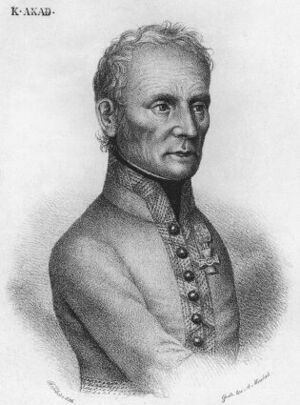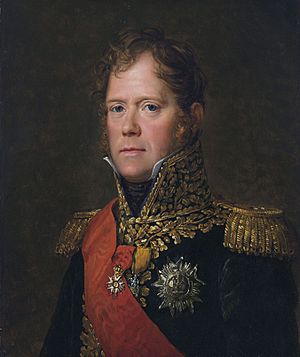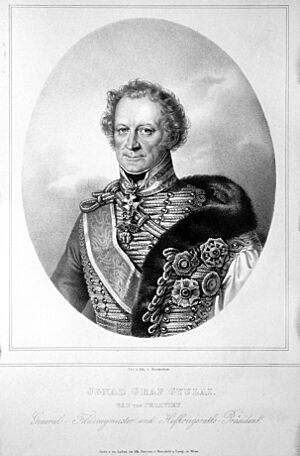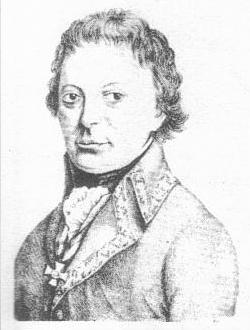Battle of Günzburg facts for kids
Quick facts for kids Battle of Günzburg |
|||||||
|---|---|---|---|---|---|---|---|
| Part of the War of the Third Coalition | |||||||
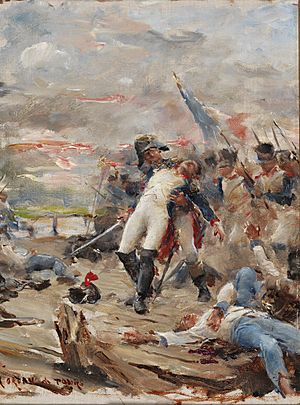 Death of Colonel Gérard Lacuée at the battle of Günzburg, on October 9, 1805. Oil painting by Georges Moreau de Tours. |
|||||||
|
|||||||
| Belligerents | |||||||
| Commanders and leaders | |||||||
| Units involved | |||||||
| Strength | |||||||
| 8,000, 6 guns | Over 7,000, 26 guns | ||||||
| Casualties and losses | |||||||
| 700 | 2,000, 6 guns | ||||||
The Battle of Günzburg happened on October 9, 1805. It was part of the War of the Third Coalition, which was a bigger conflict called the Napoleonic Wars. In this battle, a French army division led by General of Division Jean-Pierre Firmin Malher tried to take control of a bridge over the Danube River at Günzburg. They were fighting against the Austrian army, led by Lieutenant Field Marshal Karl Mack von Lieberich.
Malher's French soldiers managed to capture one of the bridges. They then held onto it even when the Austrians tried to take it back. This battle was important because it helped the French army move forward in their plan to surround the Austrian forces near the city of Ulm. After this fight, the Austrian general Mack ordered his troops to go back to Ulm, which was about 22 kilometers away.
Contents
Why Did the Battle of Günzburg Happen?
The Start of the War
After losing a war to France, Austria wanted revenge. In 1804, Austria secretly teamed up with Russia. They hoped to get financial help from Great Britain. The head of the Austrian army, Feldmarschall Archduke Charles, Duke of Teschen, thought his soldiers were not ready for another war. But other leaders in Austria wanted to fight.
Feldmarschall-Leutnant Karl Mack von Lieberich was in charge of Austria's war plan. He wanted to invade Bavaria first. He thought the Russian army would arrive in time to help the Austrians fight Napoleon. But this idea was wrong and caused many problems for the Austrians.
Napoleon's army, called the Grande Armée, had many soldiers. They were camped near the English Channel. Napoleon planned for his army to march quickly to the Rhine River, then turn towards the Danube River. On the way, they would pick up their allies from Bavaria. Another French army would keep the Austrian Archduke Charles busy in Italy. Napoleon gave the orders to start marching on August 26.
Moving Towards Günzburg
On September 8, the Austrian army invaded Bavaria. They planned to defend along the Lech River. But General Mack changed the plan. He wanted the army to go even farther west to the Iller River. The Austrian commander, Archduke Ferdinand, and his chief of staff disagreed. But Emperor Francis I of Austria supported Mack. This caused problems between Ferdinand and Mack.
On September 24, Napoleon's army started crossing the Rhine. Some French troops went east to make the Austrians think that was the main attack. But the real attack came from the northwest. By October 2, the French armies were moving south towards the Danube River.
By October 7, Napoleon's army had reached the Danube and found places to cross. When General Mack realized the French were a threat, he decided to stay near Ulm. Mack divided his army into different groups. One group was at Ulm, another at Günzburg, and others elsewhere. Mack did not prepare to defend the Danube River crossings. Instead, he wanted to attack Napoleon's supply lines.
The French easily broke through the Austrian defenses at Donauwörth. After some small fights, the Austrians retreated. On October 8, the French fought and defeated an Austrian division at the Battle of Wertingen. Napoleon thought Mack would try to retreat south. So, he sent his armies to block those paths. But Mack was actually thinking about crossing to the north side of the Danube.
The Battle at Günzburg
After the fight at Wertingen, Mack decided not to move east along the south bank of the Danube. Instead, he wanted to cross the river at Günzburg and march east on the north bank. Mack's army was spread out near Günzburg. An Austrian force was on the north bank to watch for the French and protect the bridges.
However, Marshal Michel Ney's French VI Corps had new orders to capture a crossing at Günzburg. Ney sent General of Division Jean-Pierre Firmin Malher's 3rd Division to take the bridges. Malher's division had about 8,000 soldiers and six cannons.
Malher divided his soldiers into three groups for the attack. One group went west but got stuck in a marsh. The middle group, led by General of Brigade Pierre-Louis Binet de Marcognet, went straight for the two main bridges in Günzburg. The eastern group, led by General of Brigade Mathieu Delabassé, went towards a bridge east of the town.
Marcognet's group met the Austrian guards. The Austrians in Günzburg quickly destroyed the bridges. The Austrian commander, General-major Konstantin Ghilian Karl d'Aspré, was trapped between the French and the river. He surrendered with 200 soldiers and two cannons. Malher's troops then attacked the town. Günzburg was on high ground overlooking the Danube. The Austrians had 20 cannons and fired heavily at the French. Malher brought up four cannons, but they were no match for the Austrian fire. The French tried to rebuild the bridges under fire, but they had to give up and take cover.
Even though the fighting was tough, Mack still wanted to cross to the north bank. He ordered Feldmarschall-Leutnant Ignaz Gyulai to take 7,000 soldiers and 14 cannons to the eastern bridge. Mack told Gyulai to fix the bridge, cross it, and set up a strong position on the north bank. He planned for his whole army to cross that night.
As soon as Gyulai's men fixed the bridge, the French 59th Regiment arrived. They were hours late, but they quickly broke through the Austrian defenders and took control of the bridge. Austrian cavalry (soldiers on horseback) charged the French three times. But the French soldiers formed a square, a defensive formation, and fought off each attack. Malher gathered his division to defend the bridge they had just captured. As night fell, the French controlled both ends of the bridge.
Ney's other two divisions were also busy that day. One division captured a bridge at Elchingen. Another division advanced towards Ulm.
What Happened Next?
The Austrians lost 2,000 soldiers and six cannons. Their commander, d'Aspré, was captured. The French lost 700 soldiers, including Colonel Gérard Lacuée.
With the French controlling the bridges at Günzburg and Elchingen, General Mack gave up his plan to cross the Danube. He ordered his army to retreat back to Ulm. Mack later said he didn't realize how bad the situation was because he was busy writing orders.
Marshal Ney told Napoleon that a strong Austrian force was at Ulm. However, after talking to the captured d'Aspré, Ney thought the Austrians were retreating south. Napoleon then ordered Ney to attack Ulm. He didn't realize that Ney's single corps would be fighting almost the entire Austrian army. The next big fight was the Battle of Haslach-Jungingen on October 11.
Images for kids


